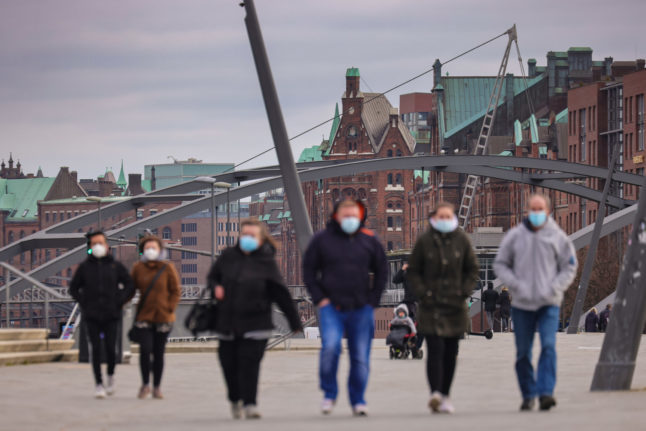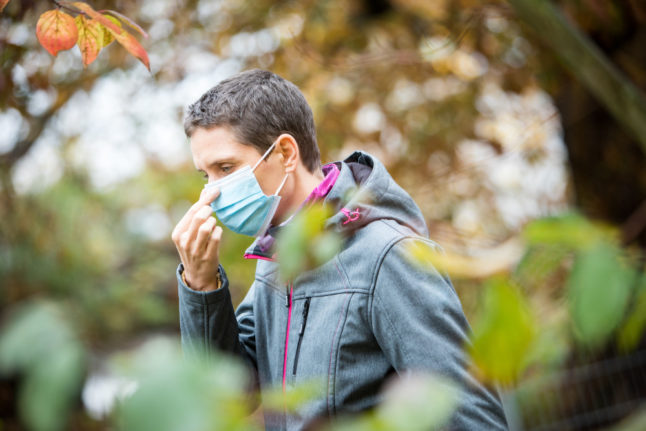Last week, German Chancellor Angela Merkel quickly overturned a strict nationwide lockdown which was put in place over the Easter long weekend, stretching from Thursday April 1st until Monday April 5th.
Yet in light of rising coronavirus figures, most German states have implemented their own measures over the holiday weekend. Here’s a look at what they’re planning.
READ ALSO: What prompted Merkel to make a sudden U-turn on Easter shutdown in Germany?
Baden-Württemberg: Curfew restrictions between 9pm and 5am are to apply in regions with a 7-day incidence of 100 new infections per 100,000 residents.
Over the holidays, five people from two households are still allowed to meet, not counting children under 14-years old.
Bavaria: Strict contact rules are to apply over Easter, and use is to be made of a ‘Notbremse’ (emergency brake): If the 7-day incidence in a district rises above 100 new infections per 100,000 residents, meetings are to be allowed only between a household and one other person. A curfew will then also apply from 10pm until 5am the following day.
Berlin: Nothing is to change in the current contact restrictions. Even over Easter, meetings with five people from two households are allowed, plus children under 14-years old. However, starting after the Easter holidays, on April 6th, the capital will introduce a nighttime curfew from 9 pm on 5 am, except for essential reasons.
Shopping will be possible on days which aren’t officially public holidays, Thursday and Saturday, but a negative coronavirus test is required for shopping in retail stores, according to new state rules which go into effect on Wednesday.
READ ALSO: EXPLAINED: How Berlin’s new coronavirus rules affect you
Brandenburg: From the Thursday before Easter to the Tuesday after Easter, a curfew from 10pm to 5am is to apply throughout the whole state. In the districts and independent cities that have 100 new infections per 100,000 residents within a week, a household may only meet with one other person.
Bremen: The 7-day incidence is currently above 100 in the Hanseatic city-state. Shopping with an appointment has been suspended since Monday. In Bremerhaven, a curfew applies from 9 pm until 5 am, a measure in effect until at least April 19th.
Hamburg: Meetings are allowed with a maximum of one person from another household. According to the State Senate, however, this only applies where the minimum distance cannot be maintained. Starting Friday, this applies between 9pm and 5am, and is set to last until at least April 18th.
READ ALSO: Hamburg moves back into hard shutdown as third coronavirus wave gains momentum

People with face masks walking on Hamburg’s Reeperbahn in early March. Photo: DPA
Hesse: Over Easter, meetings with a maximum of five people from one’s own household and one other household are allowed; children under 14 do not count. Retail shopping can only be done with an appointment made in advance. For districts with a 7-day incidence over 100, a curfew applies between 9 pm and 5 am.
Mecklenburg-Western Pomerania: In regions with a 7-day incidence of more than 100, nighttime curfew restrictions from 9pm to 6am are possible, but this is up to the district to decide. So far only one district has implemented the measure: Lundwigslust-Parchim, which had a 7-day incidence of 176 as of Thursday.
Current contact restrictions will remain in place: Two households with a total of five people are allowed to meet.
Lower Saxony: Members of a household may meet with no more than two people from another household, excluding children under 14. If the incidence is over 100 new infections per 100,000 inhabitants within seven days, members of a household may only meet with one other person. Children up to six years of age do not count.
If the 7-day incidence is 150 or more, a curfew between 9pm and 6am will be put in place. The exception is Hanover, where the curfew will begin at 10pm.
North Rhine-Westphalia: From ‘Maundy Thursday’ to Easter Monday, five people from two households are allowed to meet statewide, regardless of the local incidence of infection, the state’s Corona Protection Ordinance states. Children 14 and younger are not counted.
In municipalities with a 7-day incidence above 100, people from one household are only allowed to meet with one other person in public spaces. Stores remain open in many places, but shoppers must present a negative rapid test.
Rhineland-Palatinate: Here, too, meetings of two households with a total of five people are still permitted. In municipalities with a 7-day incidence of less than 100, outdoor restaurants are also allowed to open. A negative rapid test and reservation are prerequisites for the visit.
However, there is a curfew from 9pm to 5am in districts with where there has been a 7-day incidence of more than 100 over three days. Exceptions are made for those going to Easter church services, although in some communities they need special approval.
Saarland: Meetings of a total of five persons from a maximum of two households are also permitted.
Saxony: In some districts where the 7-day incidence is over 100, stricter contact restrictions apply: Meetings are permitted for members of one household with one other person. Otherwise, the usual restrictions apply; children up to 15 are not counted.
Saxony-Anhalt: Tighter contact restrictions are also already in place in regions with high Covid-19 infection rates: As of Tuesday, in many districts, meetings are only permitted with one person who is not from one’s own household.
Schleswig-Holstein: Meetings are generally permitted with up to five people from two households. If the 7-day incidence exceeds 100, a household may only meet with one other person. Shopping is allowed with restrictions.
Thuringia: Despite having the highest seven-day incidence nationwide, Thuringia plans to briefly relax its previously strict contact restrictions over the Easter holidays.
In the period from Good Friday to Easter Monday, two households and a maximum of five people are to be allowed to meet, according to an initial draft of the planned new Corona ordinance.
READ ALSO: Germany’s coronavirus incidence rate more than doubles in four weeks



 Please whitelist us to continue reading.
Please whitelist us to continue reading.
Member comments